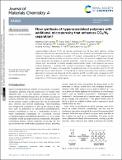Files in this item
Flow synthesis of hypercrosslinked polymers with additional microporosity that enhance CO2/N2 separations
Item metadata
| dc.contributor.author | Chanchaona, Nadhita | |
| dc.contributor.author | Ding, Liang | |
| dc.contributor.author | Lin, Shiliang | |
| dc.contributor.author | Sarwar, Sulaiman | |
| dc.contributor.author | Dimartino, Simone | |
| dc.contributor.author | Fletcher, Ashleigh J. | |
| dc.contributor.author | Dawson, Daniel McLean | |
| dc.contributor.author | Konstas, Kristina | |
| dc.contributor.author | Hill, Matthew R. | |
| dc.contributor.author | Lau, Cher Hon | |
| dc.date.accessioned | 2023-02-09T13:30:26Z | |
| dc.date.available | 2023-02-09T13:30:26Z | |
| dc.date.issued | 2023-05-14 | |
| dc.identifier | 283181195 | |
| dc.identifier | ff38d26e-eb9f-4a5f-a965-0132a9842686 | |
| dc.identifier | 85148520080 | |
| dc.identifier.citation | Chanchaona , N , Ding , L , Lin , S , Sarwar , S , Dimartino , S , Fletcher , A J , Dawson , D M , Konstas , K , Hill , M R & Lau , C H 2023 , ' Flow synthesis of hypercrosslinked polymers with additional microporosity that enhance CO 2 /N 2 separations ' , Journal of Materials Chemistry A , vol. 11 , no. 18 , pp. 9859-9867 . https://doi.org/10.1039/D2TA09253K | en |
| dc.identifier.issn | 2050-7488 | |
| dc.identifier.other | ORCID: /0000-0002-8110-4535/work/128097767 | |
| dc.identifier.uri | https://hdl.handle.net/10023/26935 | |
| dc.description | Funding: This work is financially supported by the National Metal and Materials Technology Center, Thailand. | en |
| dc.description.abstract | Hypercrosslinked polymers (HCPs) are typically synthesised over 24-hour batch reactions, limiting the ability to improve productivity rates during the scale up production of HCPs. Continuous flow synthesis can potentially overcome this limitation but the formation of insoluble HCP products, compounded by HCP expansion due to solvent adsorption during synthesis, clogged the flow reactors. In this study, we overcome clogging issues associated with both insoluble reagents and HCP products through reactor design and optimisation of synthesis time by an average of 99 %. Using this reactor, we synthesised HCPs via three known crosslinking strategies underpinned by Friedel-Crafts alkylation – internal, post-, and external crosslinking over various synthesis parameters – residence time, substrate concentration, reagent ratio, and temperature. The space-time-yield (STY) values, a key parameter for productivity rates, of flow synthesis were 32 – 117 folds higher than batch reactions. We observed that flow synthesis could create additional microporosity in internally crosslinked HCPs by limiting reaction rates. This consequently enhanced CO2/N2 selectivity 298 K by 10-folds when compared to HCPs produced in batch reactions. Outcomes from this work could potentially contribute towards high productivity scale up manufacturing of HCPs for post-carbon capture. | |
| dc.format.extent | 9 | |
| dc.format.extent | 841042 | |
| dc.language.iso | eng | |
| dc.relation.ispartof | Journal of Materials Chemistry A | en |
| dc.subject | QD Chemistry | en |
| dc.subject | NDAS | en |
| dc.subject | MCC | en |
| dc.subject.lcc | QD | en |
| dc.title | Flow synthesis of hypercrosslinked polymers with additional microporosity that enhance CO2/N2 separations | en |
| dc.type | Journal article | en |
| dc.contributor.institution | University of St Andrews. School of Chemistry | en |
| dc.contributor.institution | University of St Andrews. EaSTCHEM | en |
| dc.identifier.doi | 10.1039/D2TA09253K | |
| dc.description.status | Peer reviewed | en |
This item appears in the following Collection(s)
Items in the St Andrews Research Repository are protected by copyright, with all rights reserved, unless otherwise indicated.

